Photoacoustic Image Analysis of Dental Tissue Using Two Wavelengths: A Comparative Study
Abstract
1. Introduction
2. Materials and Methods
2.1. Signal Acquisition
2.2. Image Reconstruction Algorithm
3. Results
3.1. Photoacoustic Signal Analysis
3.2. Photoacoustic Image Analysis
4. Discussion
5. Conclusions
Author Contributions
Funding
Institutional Review Board Statement
Informed Consent Statement
Data Availability Statement
Acknowledgments
Conflicts of Interest
References
- Xia, J.; Yao, J.; Wang, L.V. Photoacoustic Tomography: Principles and Advances. Electromagn. Waves 2014, 147, 1–22. [Google Scholar] [CrossRef] [PubMed]
- Gutiérrez-Juárez, G.; Sims, M.J.; Gupta, S.K.; Viator, J.A. Application of the Pulsed Photoacoustic Spectroscopy in Biomedicine. AIP Conf. Proc. 2008, 1032, 70–78. [Google Scholar] [CrossRef]
- Upputuri, P.K.; Pramanik, M. Recent Advances toward Preclinical and Clinical Translation of Photoacoustic Tomography: A Review. J. Biomed. Opt. 2017, 22, 041006. [Google Scholar] [CrossRef] [PubMed]
- Manohar, S.; Daniel, R. Photoacoustics: A Historical Review. Adv. Opt. Photonics 2016, 8, 586–617. [Google Scholar] [CrossRef]
- Sharma, A.; Srishti; Periyasamy, V.; Pramanik, M. Photoacoustic Imaging Depth Comparison at 532, 800, and 1064 Nm Wavelengths: Monte Carlo Simulation and Experimental Validation. J. Biomed. Opt. 2019, 24, 121904. [Google Scholar] [CrossRef]
- Cheng, R.; Shao, J.; Gao, X.; Tao, C.; Ge, J.; Liu, X. Noninvasive Assessment of Early Dental Lesion Using a Dual-Contrast Photoacoustic Tomography. Sci. Rep. 2016, 6, 9. [Google Scholar] [CrossRef] [PubMed]
- Pérez-Pacheco, A.; Ramírez-Chavarría, R.G.; García, M.P.C.; Ortegón, F.d.C.C.; Siccha, R.M.Q.; Martínez-Tovar, A.; Olarte-Carrillo, I.; Parada, L.P.; Juárez, G.G. Study of Erythrocyte Sedimentation in Human Blood through the Photoacoustic Signals Analysis. Photoacoustics 2024, 37, 100599. [Google Scholar] [CrossRef]
- Treeby, B.E.; Cox, B.T. K-Wave: MATLAB Toolbox for the Simulation and Reconstruction of Photoacoustic Wave Fields. J. Biomed. Opt. 2010, 15, 12. [Google Scholar] [CrossRef] [PubMed]
- Treeby, B.E.; Zhang, E.Z.; Cox, B.T. Photoacoustic Tomography in Absorbing Acoustic Media Using Time Reversal. Inverse Probl. 2010, 26, 21798. [Google Scholar] [CrossRef]
- Pramanik, M. Improving Tangential Resolution with a Modified Delay-and-Sum Reconstruction Algorithm in Photoacoustic and Thermoacoustic Tomography. J. Opt. Soc. Am. A 2014, 31, 621. [Google Scholar] [CrossRef]
- Jeon, S.; Park, E.-Y.; Choi, W.; Managuli, R.; Lee, K.J.; Kim, C. Real-Time Delay-Multiply-and-Sum Beamforming with Coherence Factor for in Vivo Clinical Photoacoustic Imaging of Humans. Photoacoustics 2019, 15, 100136. [Google Scholar] [CrossRef] [PubMed]
- Köstli, K.P.; Beard, P.C. Two-Dimensional Photoacoustic Imaging by Use of Fourier-Transform Image Reconstruction and a Detector with an Anisotropic Response. Appl. Opt. 2003, 42, 1899. [Google Scholar] [CrossRef] [PubMed]
- Haltmeier, M.; Scherzer, O.; Zangerl, G. A Reconstruction Algorithm for Photoacoustic Imaging Based on the Nonuniform FFT. IEEE Trans. Med. Imaging 2009, 28, 1727–1735. [Google Scholar] [CrossRef] [PubMed]
- Xu, M.; Wang, L.V. Universal Back-Projection Algorithm for Photoacoustic Computed Tomography. Phys. Rev. E Stat. Nonlinear Soft Matter Phys. 2005, 71, 016706. [Google Scholar] [CrossRef] [PubMed]
- Wang, B.; Su, T.; Pang, W.; Wei, N.; Xiao, J.; Peng, K. Back-Projection Algorithm in Generalized Form for Circular-Scanning-Based Photoacoustic Tomography with Improved Tangential Resolution. Quant. Imaging Med. Surg. 2019, 9, 491–502. [Google Scholar] [CrossRef] [PubMed]
- Featherstone, J.D.B.; Fried, D. Fundamental Interactions of Lasers with Dental Hard Tissues. Med. Laser Appl. 2001, 16, 181–194. [Google Scholar] [CrossRef]
- Blodgett, D.W. Ultrasonic Assessment of Tooth Structure. In Laser Tissue Interaction XIII: Photochemical, Photothermal, and Photomechanical; SPIE: Bellingham, WA, USA, 2002; Volume 4617, pp. 284–288. [Google Scholar] [CrossRef]
- Luk, K.; Zhao, I.S.; Gutknecht, N.; Chu, C.H. Use of Carbon Dioxide Lasers in Dentistry. Lasers Dent. Sci. 2019, 3, 1–9. [Google Scholar] [CrossRef]
- Da Silva, T.M.; De Oliveira, H.P.M.; Severino, D.; Balducci, I.; Huhtala, M.F.R.L.; Gonçalves, S.E.P. Direct Spectrometry: A New Alternative for Measuring the Fluorescence of Composite Resins and Dental Tissues. Oper. Dent. 2014, 39, 407–415. [Google Scholar] [CrossRef]
- Gómez, C.; Costela, Á.; García-Moreno, I.; García, J.A. In Vitro Evaluation of Nd:YAG Laser Radiation at Three Different Wavelengths (1064, 532, and 355 Nm) on Calculus Removal in Comparison with Ultrasonic Scaling. Photomed. Laser Surg. 2006, 24, 366–376. [Google Scholar] [CrossRef]
- Windra Sari, A.; Widyaningrum, R.; Setiawan, A.; Mitrayana. Recent Development of Photoacoustic Imaging in Dentistry: A Review on Studies over the Last Decade. Saudi Dent. J. 2023, 35, 423–436. [Google Scholar] [CrossRef]
- Culjat, M.; Singh, R.S.; Yoon, D.C.; Brown, E.R. Imaging of Human Tooth Enamel Using Ultrasound. IEEE Trans. Med. Imaging 2003, 22, 526–529. [Google Scholar] [CrossRef]
- Ghorayeb, S.; Bertoncini, C.; Hinders, M. Ultrasonography in Dentistry. IEEE Trans. Ultrason. Ferroelectr. Freq. Control. 2008, 55, 1256–1266. [Google Scholar] [CrossRef]
- Periyasamy, V.; Rangaraj, M.; Pramanik, M. Photoacoustic Imaging of Teeth for Dentine Imaging and Enamel Characterization. In Lasers Dentistry XXIV; SPIE: Bellingham, WA, USA, 2018; Volume 1047309. [Google Scholar] [CrossRef]
- Moore, C.; Bai, Y.; Hariri, A.; Sanchez, J.B.; Lin, C.Y.; Koka, S.; Sedghizadeh, P.; Chen, C.; Jokerst, J.V. Photoacoustic Imaging for Monitoring Periodontal Health: A First Human Study. Photoacoustics 2018, 12, 67–74. [Google Scholar] [CrossRef]
- Fu, L.; Ling, C.; Jin, Z.; Luo, J.; Palma-Chavez, J.; Wu, Z.; Zhou, J.; Zhou, J.; Donovan, B.; Qi, B.; et al. Photoacoustic Imaging of Posterior Periodontal Pocket Using a Commercial Hockey-Stick Transducer. J. Biomed. Opt. 2022, 27, 11. [Google Scholar] [CrossRef]
- Ruiz-Veloz, M.; Gutiérrez-Juárez, G.; Polo-Parada, L.; Cortalezzi, F.; Kline, D.D.; Dantzler, H.A.; Cruz-Alvarez, L.; Castro-Beltrán, R.; Hidalgo-Valadez, C. Image Reconstruction Algorithm for Laser-Induced Ultrasonic Imaging: The Single Sensor Scanning Synthetic Aperture Focusing Technique. J. Acoust. Soc. Am. 2023, 153, 560–572. [Google Scholar] [CrossRef]
- Schmerr, L.W. Fundamentals of Ultrasonic Phased Arrays; Springer: Cham, Switzerland, 2015; Volume 215, ISBN 978-3-319-07271-5. [Google Scholar]
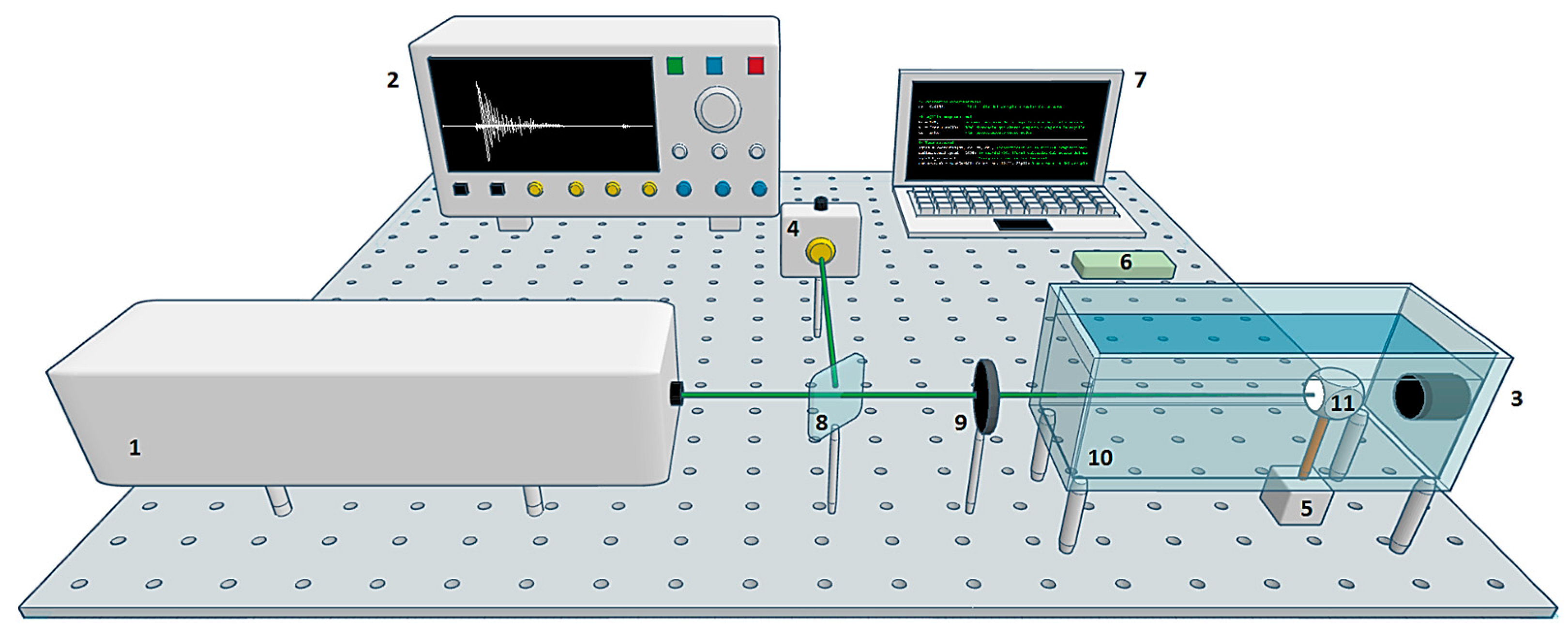
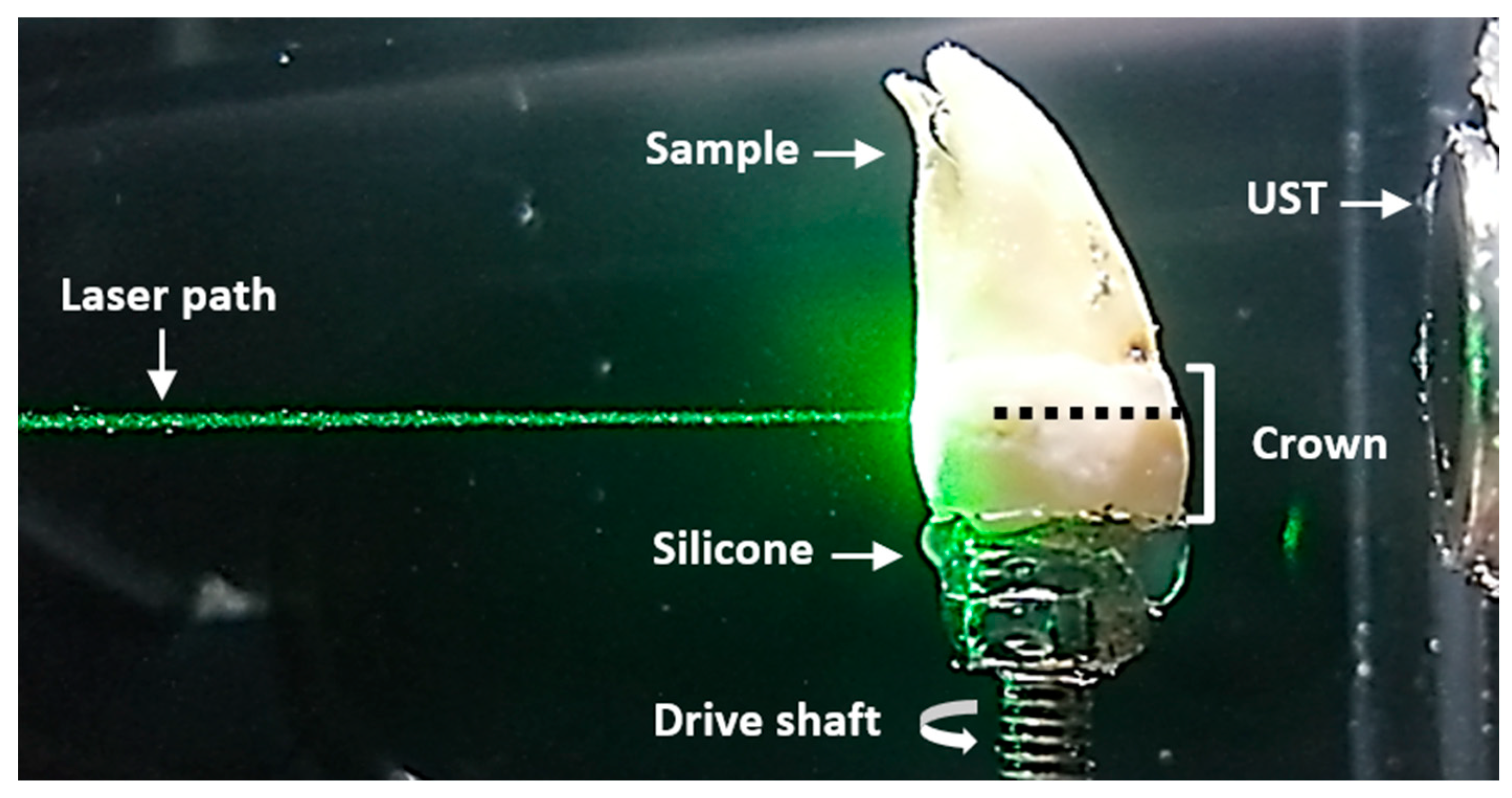
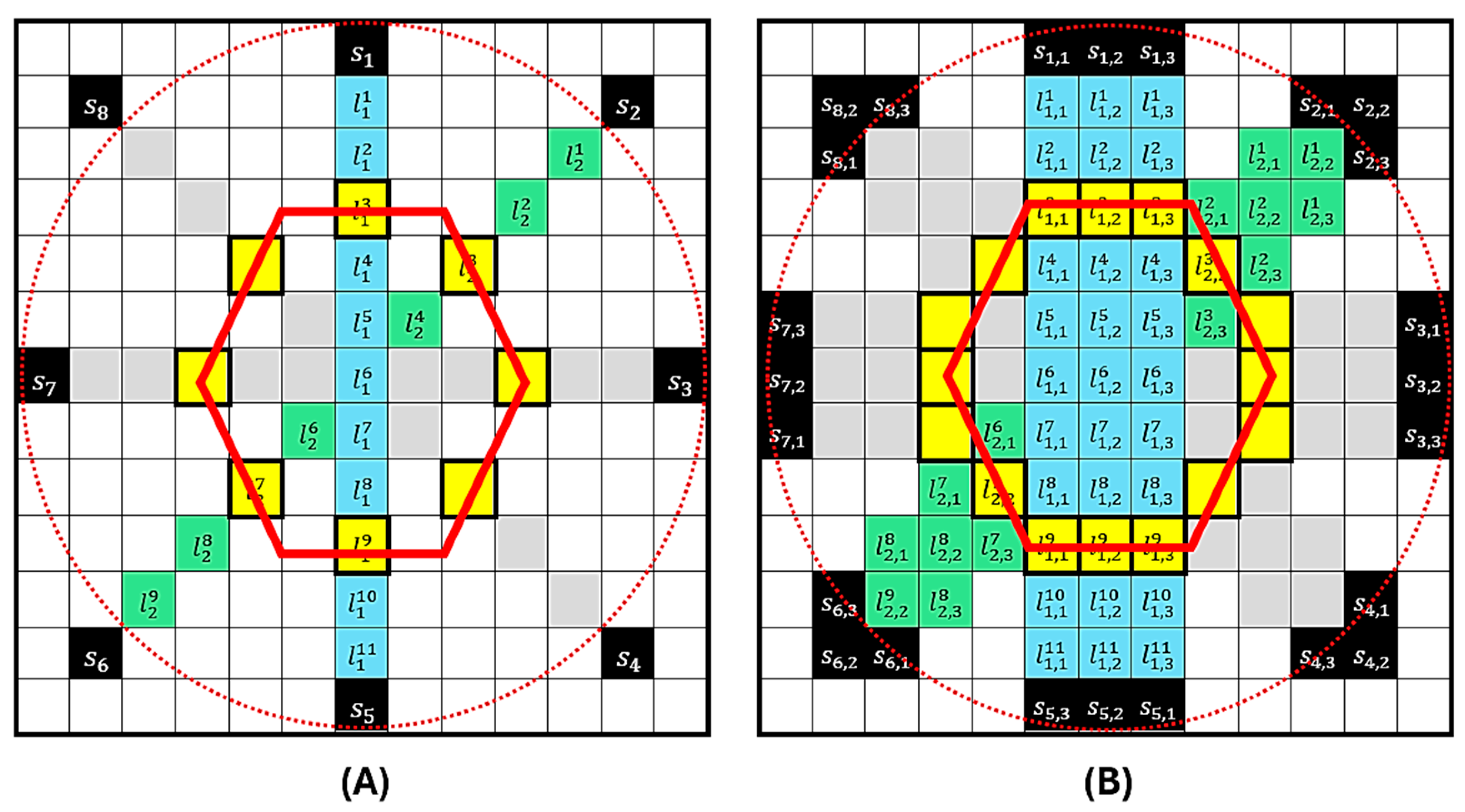
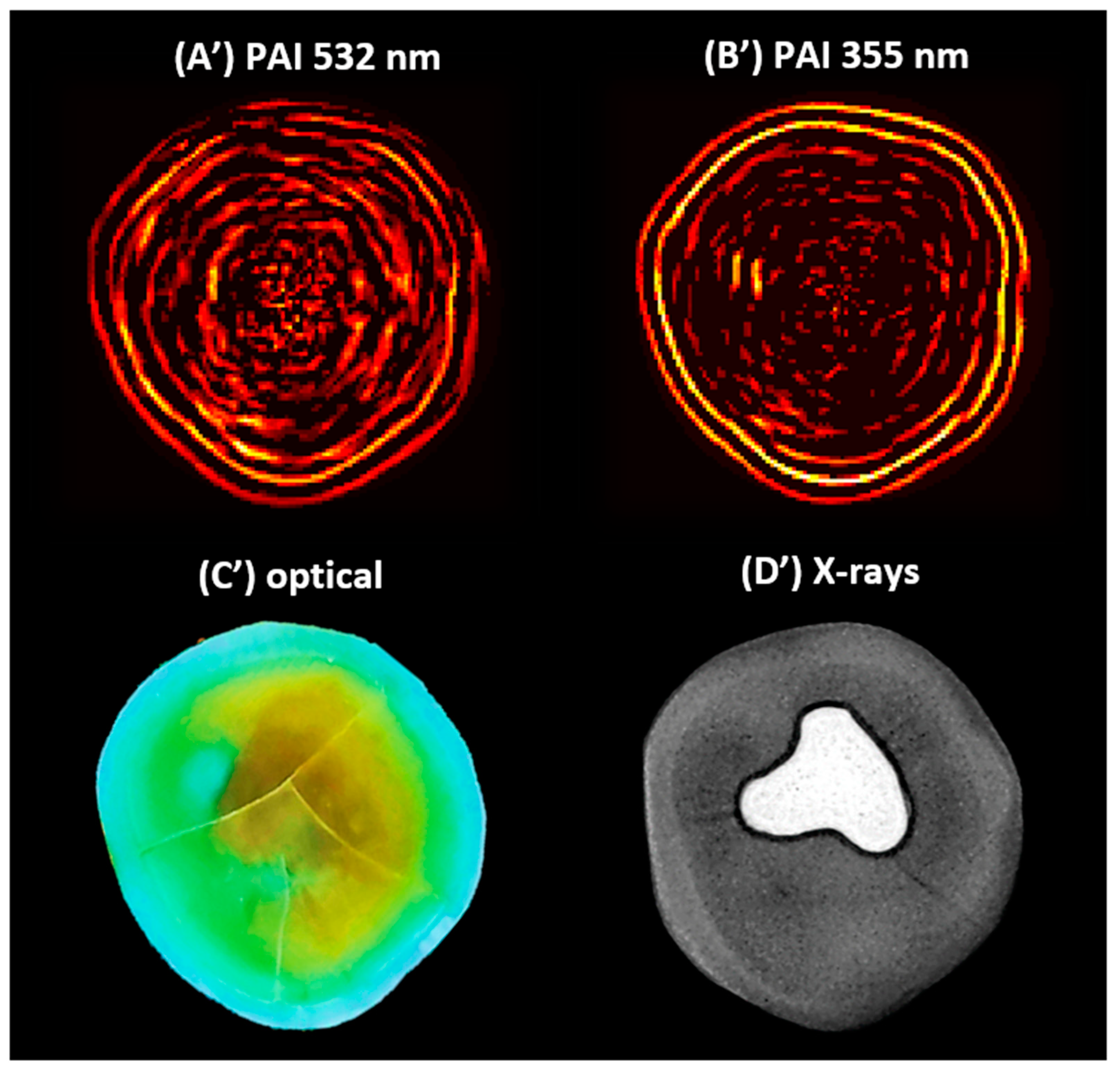
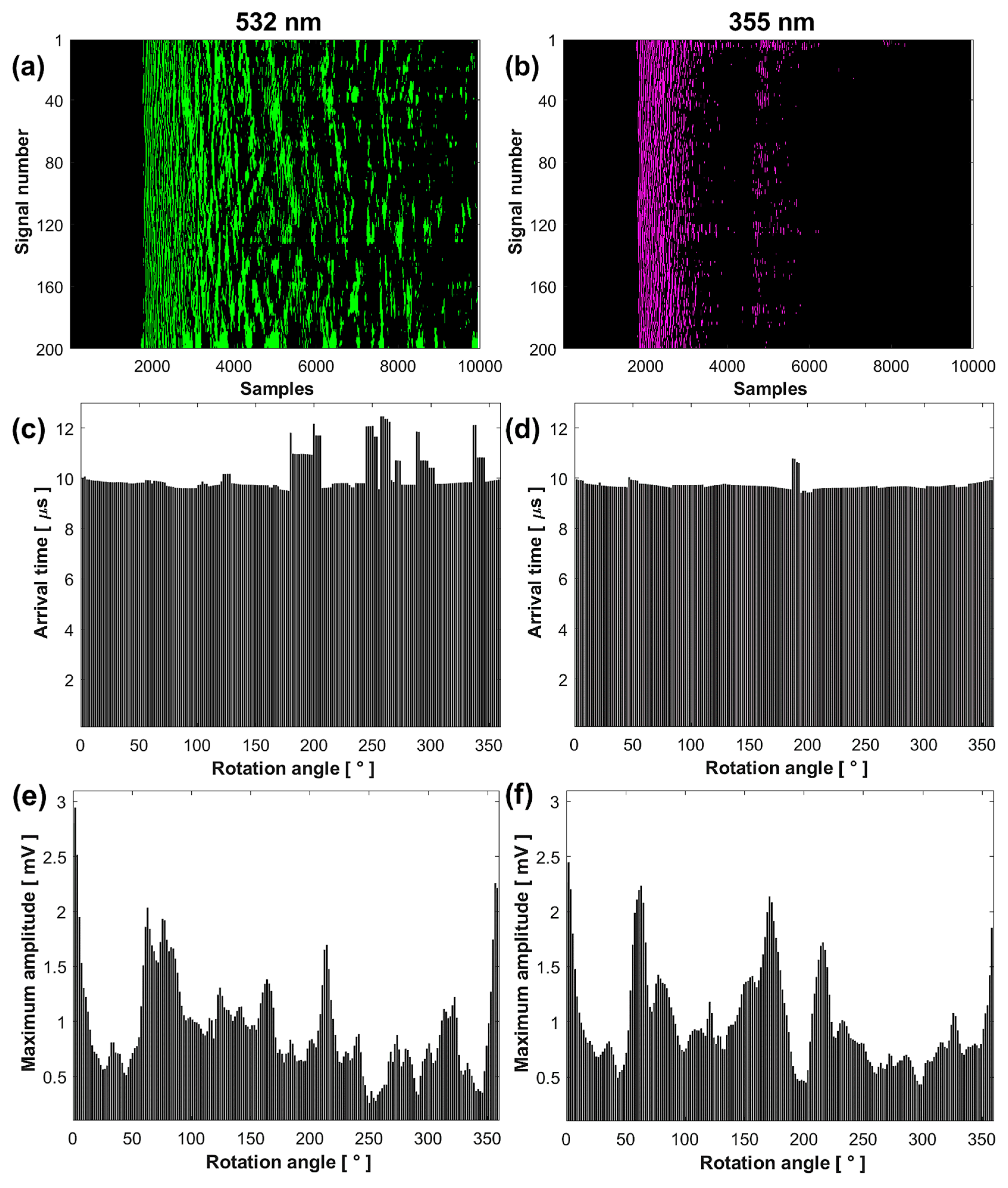

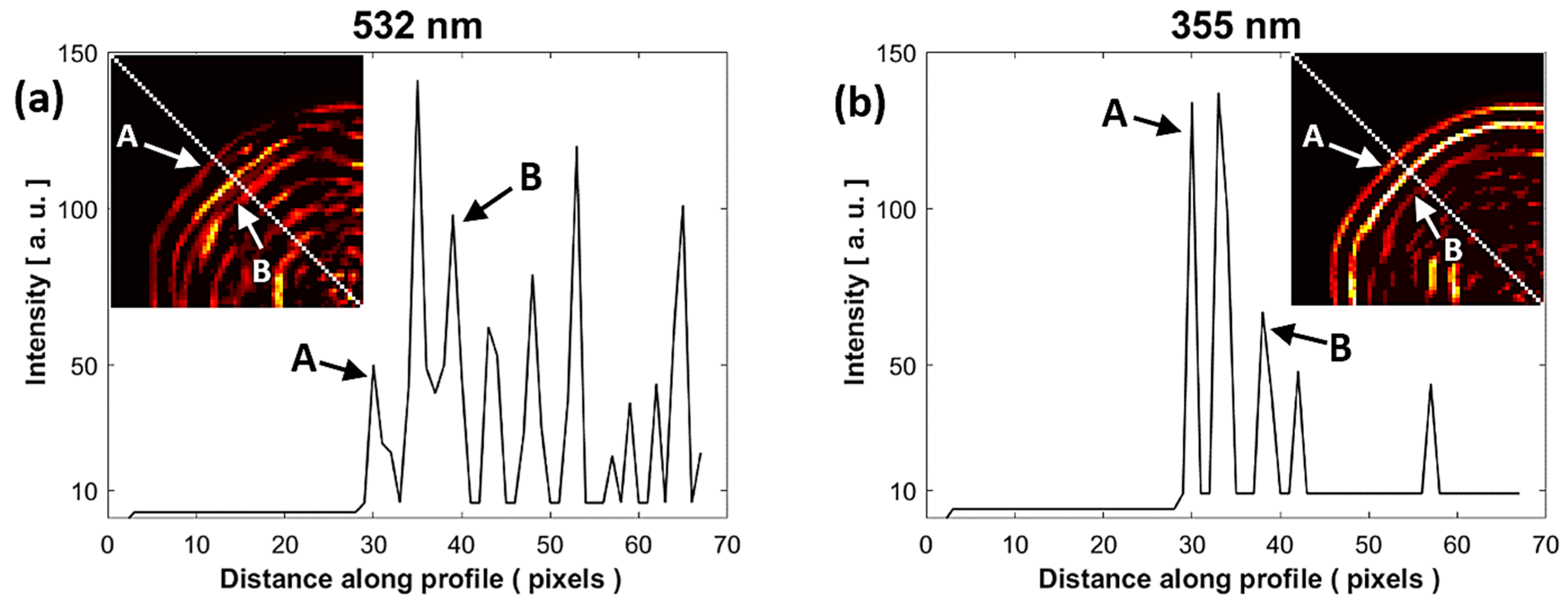

Disclaimer/Publisher’s Note: The statements, opinions and data contained in all publications are solely those of the individual author(s) and contributor(s) and not of MDPI and/or the editor(s). MDPI and/or the editor(s) disclaim responsibility for any injury to people or property resulting from any ideas, methods, instructions or products referred to in the content. |
© 2024 by the authors. Licensee MDPI, Basel, Switzerland. This article is an open access article distributed under the terms and conditions of the Creative Commons Attribution (CC BY) license (https://creativecommons.org/licenses/by/4.0/).
Share and Cite
Colín-García, M.P.; Ruiz-Veloz, M.; Polo-Parada, L.; Castañeda-Guzmán, R.; Gutiérrez-Juárez, G.; Pérez-Pacheco, A.; Ramírez-Chavarría, R.G. Photoacoustic Image Analysis of Dental Tissue Using Two Wavelengths: A Comparative Study. Photonics 2024, 11, 678. https://doi.org/10.3390/photonics11070678
Colín-García MP, Ruiz-Veloz M, Polo-Parada L, Castañeda-Guzmán R, Gutiérrez-Juárez G, Pérez-Pacheco A, Ramírez-Chavarría RG. Photoacoustic Image Analysis of Dental Tissue Using Two Wavelengths: A Comparative Study. Photonics. 2024; 11(7):678. https://doi.org/10.3390/photonics11070678
Chicago/Turabian StyleColín-García, Marco P., Misael Ruiz-Veloz, Luis Polo-Parada, Rosalba Castañeda-Guzmán, Gerardo Gutiérrez-Juárez, Argelia Pérez-Pacheco, and Roberto G. Ramírez-Chavarría. 2024. "Photoacoustic Image Analysis of Dental Tissue Using Two Wavelengths: A Comparative Study" Photonics 11, no. 7: 678. https://doi.org/10.3390/photonics11070678
APA StyleColín-García, M. P., Ruiz-Veloz, M., Polo-Parada, L., Castañeda-Guzmán, R., Gutiérrez-Juárez, G., Pérez-Pacheco, A., & Ramírez-Chavarría, R. G. (2024). Photoacoustic Image Analysis of Dental Tissue Using Two Wavelengths: A Comparative Study. Photonics, 11(7), 678. https://doi.org/10.3390/photonics11070678





